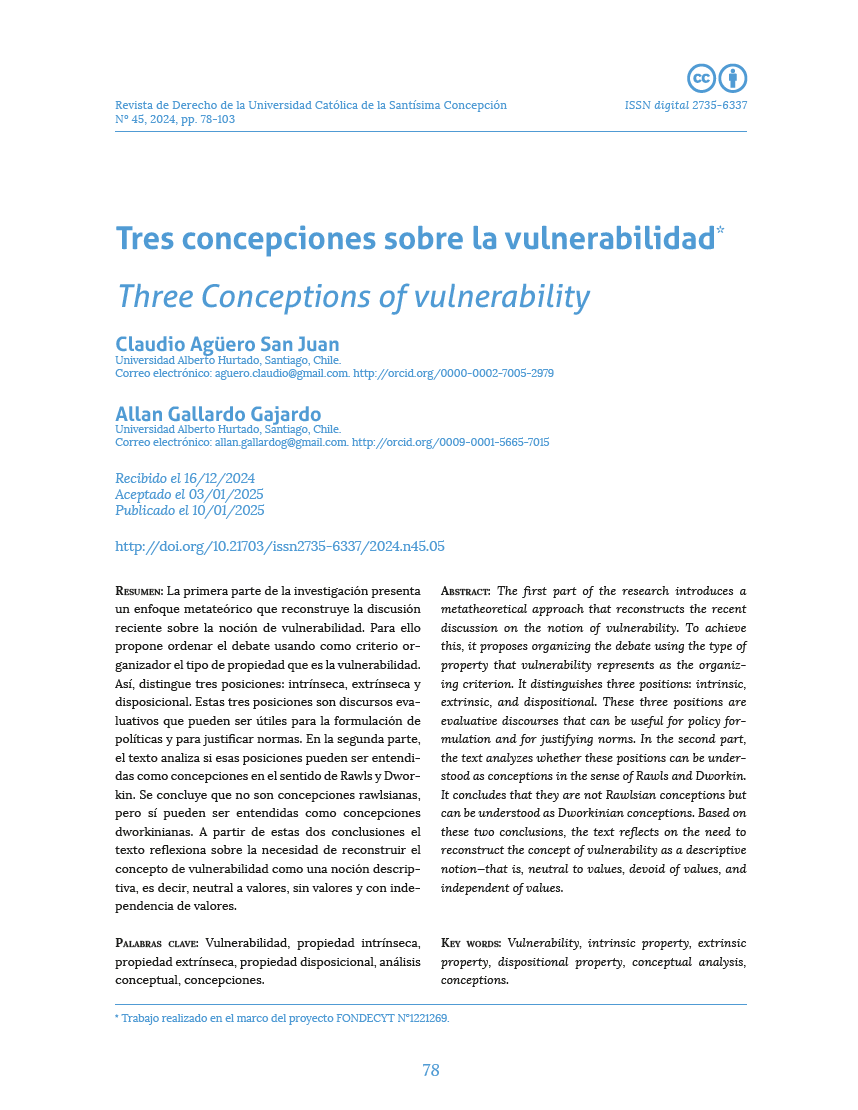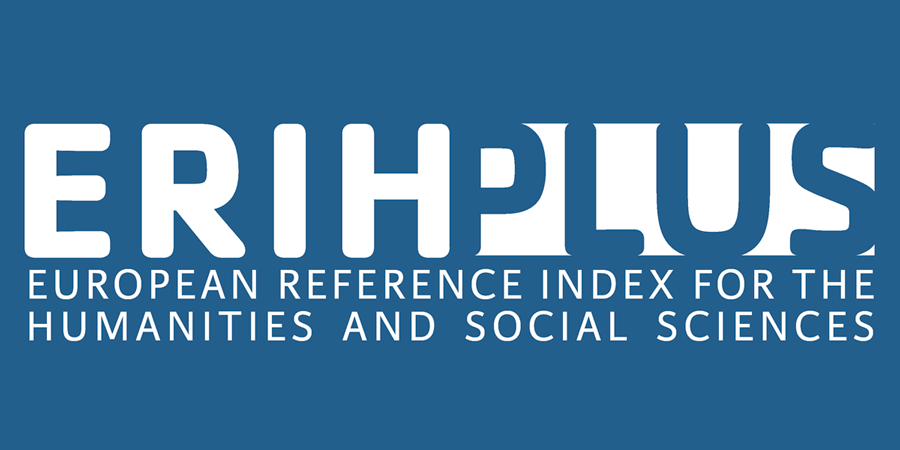Three conceptions on vulnerability
DOI:
https://doi.org/10.21703/issn2735-6337/2024.n45.05Keywords:
Vulnerability, intrinsic property, extrinsic property, dispositional property, conceptual analysis, conceptionsAbstract
The first part of the research introduces a metatheoretical approach that reconstructs the recent discussion on the notion of vulnerability. To achieve this, it proposes organizing the debate using the type of property that vulnerability represents as the organizing criterion. It distinguishes three positions: intrinsic, extrinsic, and dispositional. These three positions are evaluative discourses that can be useful for policy formulation and for justifying norms. In the second part, the text analyzes whether these positions can be understood as conceptions in the sense of Rawls and Dworkin. It concludes that they are not Rawlsian conceptions but can be understood as Dworkinian conceptions. Based on these two conclusions, the text reflects on the need to reconstruct the concept of vulnerability as a descriptive notion—that is, neutral to values, devoid of values, and independent of values.
Downloads
References
Doctrina citada
AGRAWAL, Manish (2003): “Voluntariness in Clinical Research at the End of Life”, en: Journal of Pain and Symptom Management (vol. 25 núm. 4).
ARMSTRONG, Frédérick (2017): “An extrinsic dispositional account of vulnerability”, en: Les ateliers de l’éthique (vol. 12 núm. 2-3).
BIGLIA, Bárbara y BONET MARTÍ, Jordi (2014): “Precarity”, en: Teo, Thomas (editor), Encyclopedia of critical psychology (New York, Springer).
BUTLER, Judith (2004): “Precarious Life, Vulnerability, and the Ethics of Cohabitation”, en: The Journal of Speculative Philosophy (vol. 26 núm. 2).
CARTER, Ian (2015): “Value-freeness and value-neutrality in the analysis of political concepts”, en: Sobe, David; Vallentyne, Peter y Wall, Steven (editors), Oxford studies in political philosophy (Oxford, Oxford University Press), vol. I.
CASALINI, Brunella (2018): “Le teorie femministe contemporanee, dal paradigma della sovranità al paradigma della vulnerabilità”, en: Bernardini, Maria Giulia; Casalini, Brunella; Giolo, Orsetta y Re, Lucia (a cura di), Vulnerabilità: Etica, politica, diritto (Roma, IF Press).
CHAMBERS, Robert (2006): “Vulnerability, Coping and Policy (Editorial Introduction)”, en: IDS Bulletin (vol. 37 núm. 4).
CHOW, Sheldon (2015): “Many Meanings of «Heuristic»”, en: The British Journal for the Philosophy of Science (vol. 66 núm. 4).
COMANDUCCI, Paolo (1998): “Igualdad liberal”, en: Revista jurídica de la universidad de Palermo (año 3 núm. 2).
COUNCIL FOR INTERNATIONAL ORGANIZATIONS OF MEDICAL SCIENCES (2002): International ethical guidelines for health-related research involving humans. Council for International Organizations of Medical Sciences (CIOMS). Disponible en: https://cioms.ch/publications/product/international-ethical-guidelines-for-health-related-research-involving-humans/
COUNCIL FOR INTERNATIONAL ORGANIZATIONS OF MEDICAL SCIENCES (2016): International Ethical Guidelines for Health-related Research involving Humans. Council for International Organizations of Medical Sciences (CIOMS). Disponible en: https://cioms.ch/publications/product/international-ethical-guidelines-for-health-related-research-involving-humans/
DUNN, J. Michael (1990): “Relevant Predication 2: Intrinsic Properties and Internal Relations”, en: Philosophical Studies: An International Journal for Philosophy in the Analytic Tradition (vol. 60 núm. 3).
DWORKIN, Ronald (1986): Law’s Empire (Cambridge, Harvard University Press).
EZCURDIA, Maite (1998): “The Concept-Conception Distinction”, en: Philosophical Issues (vol. 9).
FLEW, Antony (1985): “The Concept, and Conceptions, of Justice”, en: Journal of Applied Philosophy (vol. 2 núm. 2).
FRYDRYCH, David (2017): “Down the methodological rabbit hole”, en: Crítica (México D F En línea) (vol. 49 núm. 147).
GALLIE, Walter (1956): “Essentially Contested Concepts”, en: Proceedings of the Aristotelian Society (vol. 56 núm. 1).
GARZÓN VALDÉS, Ernesto (1988): “Acerca del concepto de legitimidad”, en: Anuario de derechos humanos (vol. 5).
GARZÓN VALDÉS, Ernesto (1992): “No pongas tus sucias manos sobre Mozart. Algunas consideraciones sobre el concepto de tolerancia”, en: Claves de Razón Práctica (vol. 19).
GILSON, Erinn (2014): The ethics of vulnerability: A feminist analysis of social life and practice (New York, Routledge).
GINSBERG, Morris (1963): “The Concept of Justice”, en: Philosophy (vol. 38 núm. 144).
GOODIN, Robert (1986): Protecting the Vulnerable. A reanalysis of our social responsabilities (Chicago, University of Chicago Press).
HALPIN, Andrew (1997): Rights and Law, Analysis and Theory (Oxford, Hart Press).
HARROSH, Shlomit (2012): “Identifying Harms”, en: Bioethics (vol. 26 núm. 9).
HART, Herbert (1961): The concept of law (Oxford, Clarendon Press).
HIGGINBOTHAM, James (1998): “Conceptual Competence”, en: Philosophical Issues (vol. 9).
HURST, Samia (2008): “Vulnerability in research and health care; describing the elephant in the room?”, en: Bioethics (vol. 22 núm. 4).
HURST, Samia (2020): “Vulnerability in Old Age. The Fragility of Inappropriately Protected Interests”, en: Schweda, Mark; Coors, Michael y Bozzaro, Claudia (editores), Aging and Human Nature: Perspectives from Philosophical, Theological, and Historical Anthropology (Berlin, Springer).
INTER AMERICAN DEVELOPMENT BANK & ECONOMIC COMMISSION FOR LATIN AMERICA AND THE CARIBBEAN (2000): Un tema del desarrollo: La reducción de la vulnerabilidad frente a los desastres. Disponible en: https://publications.iadb.org/es/publicacion/15833/un-tema-del-desarrollo-la-reduccion-de-la-vulnerabilidad-frente-los-desastres
IPPOLITO, Francesca (2019): “Vulnerability as a normative argument for accommodating “justice” within the AFSJ”, en: European Law Journal (vol. 25 núm. 6).
JUÁREZ GUTIÉRREZ, María del Carmen; IÑIGUEZ ROJAS, Luisa y SÁNCHEZ CELADA, Miguel Ángel (2006): “Niveles de riesgo social frente a desastres naturales en la Riviera Mexicana”, en: Investigaciones geográficas (vol. 61).
LALUMERA, Elisabetta (2014): “On the Explanatory Value of the Concept Conception Distinction”, en: Rivista Italiana di Filosofia del Linguaggio (vol. 8 núm. 2).
LEVINAS, Emmanuel (2012): Totalidad e infinito (Salamanca, Sígueme).
LEVINE, Carol; FADEN, Ruth; GRADY, Christine; HAMMERSCHMIDT, Dale; ECKENWILER, Lisa y SUGARMAN, Jeremy (2004): “The Limitations of “Vulnerability” as a Protection for Human Research Participants”, en: The American Journal of Bioethics (vol. 4 núm. 3).
LEWIS, David (1983): “Extrinsic Properties”, en: Philosophical Studies: An International Journal for Philosophy in the Analytic Tradition (vol. 44 núm. 2).
LEWIS, David (1986): On the plurality of worlds (Oxford, Blackwell Publishers).
LIEDO, Belén (2021): “Vulnerabilidad”, en: EUNOMÍA. Revista en Cultura de la Legalidad (núm. 20).
LUNA, Florencia (2009): “Elucidating the concept of vulnerability: Layers not labels”, en: IJFAB: International Journal of Feminist Approaches to Bioethics (vol. 2 núm. 1).
LUNA, Florencia (2019): “Identifying and evaluating layers of vulnerability – a way forward”, en: Developing World Bioethics (vol. 19 núm. 2).
LUNA, Florencia (2021): Grupos en situación de vulnerabilidad. Disponible en: https://biblio.juridicas.unam.mx/bjv/detalle-libro/6503-covid-19-y-bioetica
MACKENZIE, Catriona; ROGERS, Wendy y DODDS, Susan (editoras) (2013): Vulnerability: New Essays in Ethics and Feminist Philosophy (Oxford, Oxford University Press).
MACKLIN, Ruth (2003): “Bioethics, Vulnerability, and Protection”, en: Bioethics (vol. 17 núm. 5-6).
MACKLIN, Ruth (2012): “A global ethics approach to vulnerability”, en: International Journal of Femonist Approaches to Bioethics (vol. 5 núm. 2).
MARTIN, Angela y HURST, Samia (2017): “On vulnerability—analysis and applications of a many-faceted concept: Introduction”, en: Les Ateliers de l’éthique / The Ethics Forum (vol. 12 núm. 2-3).
MARTIN, Angela; TAVAGLIONE, Nicolas y HURST, Samia (2014): “Resolving the Conflict: Clarifying ‘Vulnerability’ in Health Care Ethics”, en: Kennedy Institute of Ethics Journal (vol. 24 núm. 1).
MCKITRICK, Jennifer (2003): “A Case for Extrinsic Dispositions”, en: Australasian Journal of Philosophy. Australian Association of Philosophy (vol. 81 núm. 2).
NINO, Carlos (1991): Introducción al análisis del derecho, 4a edición (Barcelona, Ariel).
PARIOTTI, Elena (2023): “Vulnerability and Human Rights: Which Compatibility?”, en: International Journal for the Semiotics of Law - Revue Internationale de Sémiotique Juridique (vol. 36 núm. 4).
PARK, Seungbae (2017): “Against Extrinsic Dispositions”, en: Review of Contemporary Philosophy (vol. 16).
PASTORE, Baldassare (2022): “Vulnerabilità, diritto, ragionamento giuridico”, en: Teoría e Storia del Diritto Privato (Numero speciale Anno 2012 Ombre del diritto).
PÉREZ LUÑO, Antonio (1987): “Concepto y concepción de los derechos humanos”, en: Doxa. Cuadernos de Filosofía del Derecho (vol. 4).
RAWLS, Jhon (1971): A theory of justice (Cambridge, Belknap Press).
RAZ, Joseph (1986): “Review: Dworkin: A New Link in the Chain”, en: California Law Review. Symposium: New Perspectives in the Law of Defamation (vol. 74 núm. 3).
REGAN, Tom (2004): The case for animal rights (Los Angeles, University of California press).
SANCHES, Mario; MANNES, Mariel y ROCHA DA CUNHA, Thiago (2018): “Moral vulnerability: A view of exclusions in the contexts of bioethics”, en: Revista Bioética (vol. 26 núm. 1).
SANCHINI, Virginia; SALA, Roberta y GASTMANS, Chris (2022): “The concept of vulnerability in aged care: A systematic review of argument-based ethics literature”, en: BMC Medical Ethics (vol. 23 núm. 1).
SEN, Amartya (1985a): Commodities and Capabilities (Oxford, Oxford University Press).
SEN, Amartya (1985b): “Well-Being, Agency and Freedom: The Dewey Lectures 1984”, en: The Journal of Philosophy (vol. 82 núm. 4).
SHIVAS, Tricha (2004): “Contextualizing the Vulnerability Standard”, en: The American Journal of Bioethics (vol. 4 núm. 3).
SIDER, Theodore (1996): “Intrinsic Properties”, en: Philosophical Studies: An International Journal for Philosophy in the Analytic Tradition (vol. 83 núm. 1).
SWANTON, Christine (1992): Freedom: A Coherence Theory (Indianapolis, Hackett Pub Co Inc).
TAPPOLET, Christine (2014): “The Normativity of Evaluative Concepts”, en: Reboul, Anne (editora), Mind, Values, and Metaphysics. Philosophical Essays in Honor of Kevin Mulligan, volume 2 (Cham, Springer).
TAPPOLET, Christine (2021): “Evaluative Vs. Deontic Concepts”, en: LaFollette, Hugh (editor), International Encyclopedia of Ethics (Hoboken, Wiley).
TAVAGLIONE, Nicolas; MARTIN, Angela; MEZGER, Nathalie; DURIEUX‐PAILLARD, Sophie; FRANÇOIS, Anne; JACKSON, Yves y HURST, Samia (2015): “Fleshing Out Vulnerability”, en: Bioethics (vol. 29 núm. 2).
VROUSALIS, Nicholas (2013): “Exploitation, Vulnerability, and Social Domination”, en: Philosophy & Public Affairs (vol. 41 núm. 2).
WHITE, A. (1975): “Conceptual Analysis”, en: Bontempo, Charles (editor), The Owl of Minerva: Philosophers on Philosophy (New York, McGraw-Hill).
WORLD MEDICAL ASSOCIATION (2013): “World Medical Association Declaration of Helsinki: Ethical Principles for Medical Research Involving Human Subjects”, en: JAMA (vol. 310 núm. 20).

Downloads
Published
Issue
Section
License
Copyright (c) 2024 Revista de Derecho de la Universidad Católica de la Santísima Concepción

This work is licensed under a Creative Commons Attribution 4.0 International License.












